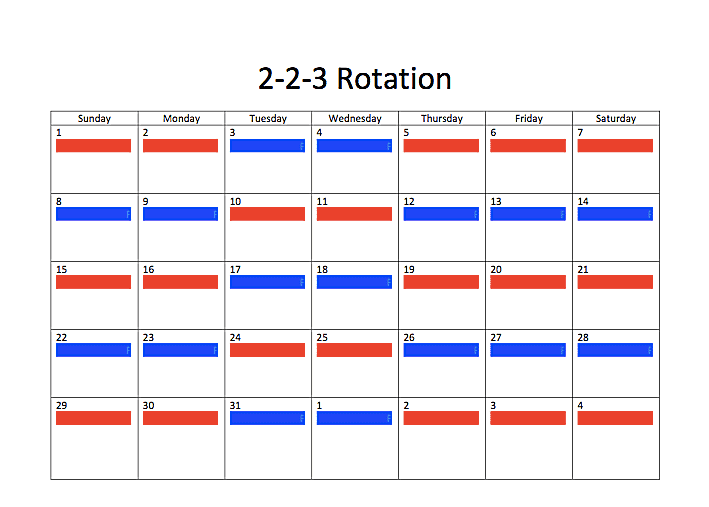A 2–2–3 schedule is followed by someone I know. He might work two days and then take two days off, for instance. After taking another two days off, he will return to work for another two days. Last but not least, he will work three days followed by a three-day weekend. That essentially means he works 7 out of 14 days.
But, is a 2–2–3 schedule effective? How to set up 2–2–3 schedule? What are the pros and cons of 2–2–3 schedule?
Please read on for more information.
Table of Contents
2-2-3 Schedule Description
Each employee works twelve-hour shifts over the course of a 28-day rotational cycle known as the 2-2-3 or Panama schedule.
Four teams typically follow the 2-2-3 work schedule, which entails two days of work, two days off, and then three days of work. This is repeated every week, but the second week starts with 2 rest days, followed by 2 workdays and 3 rest days. Then, starting at the beginning of week 3, this is repeated. 14 12-hour shifts typically make up one month.
Who Is Effective For The 2-2-3 Schedule?
The 2-2-3 parenting strategy calls for frequent moving of the children. It’s great for parents who live close to one another because of this.
However, it’s still beneficial for parents who reside far apart. The schedule for this project includes a long weekend. This enables both parents to spend time with their children without taking time away from work.
There are some limitations to the 2-2-3 schedule, though.
The kids, for instance, alternate between two homes quite frequently. You’ll therefore need to become an expert packer, just like your ex.
Alternately, you’ll need two sets of everything, divided between the two houses. In this manner, whichever parent your kids spend a short time with will be able to give them what they want.
Your older children may struggle with the 2-2-3 schedule as well, especially if they have a hectic schedule full of extracurricular activities. For instance, if they attend band practice every Tuesday and Thursday, they would attend practice at a different parent’s home each week and day. If they have to travel quite a distance to practice from a parent’s house, this may be challenging for them.
How To Set Up A 2-2-3 Schedule?
The 2-2-3 work schedule is among the most practical and adaptable, but if it isn’t followed carefully, it can pose challenges.
Here are some pointers to assist you in implementing and maintaining a 2-2-3 schedule:
Setting A Proper Start Time
Your employees must feel comfortable with the time their shifts start. Because every team has different preferences, there is no correct advice in this situation. For instance, if the majority of your staff members rise early, you can start the shifts at 5:00. If many employees would rather not start that early, you might have to switch to another time. To ensure the team is as productive as possible, it is crucial that they feel at ease with the shift times.
Assisting New Employees
The 2-2-3 work schedule may take some time for new employees to mentally and physically adjust to. It’s possible that their bodies aren’t (yet) capable of handling the workload. Their private and professional lives may suffer as a result. For instance, a novice worker who worked a night shift the night before is more likely than an experienced worker to make a mistake the following day. The rotating schedule could cause your new employees to become exhausted, have trouble sleeping, and experience other problems. As a manager, it is crucial to regularly look for any indications of fatigue. You can help them get accustomed to the workload and unusual shift schedules; a wise move is to enlist the assistance of more seasoned workers.
Encouraging Productive Breaks
Your employees will feel more refreshed if they take regular, brief breaks. They are free to do anything that gives them new energy during the break, such as take a nap or go for a walk. Some workers prefer to take a 45-minute break each time. However, some employees choose to wait until 75 to 90 minutes have passed before taking a break. Establishing a minimum and maximum for breaks is a good idea. This guarantees that both adequate sleep and adequate work are received.
Anticipating Potential Problems
Replacements must be scheduled frequently when someone is out on leave, just like in any other workplace. This might be a result of an illness, a vacation, etc. When a replacement is required, you want to make sure that it works with the schedule of the person taking the shift. Every four weeks, each team fills in for its teammates. So that they don’t have too many shifts during that week if they need to replace someone, you can divide the teams according to the week in which they themselves have the fewest shifts. To ensure that there is a fair alternation of people who take over their colleagues’ shifts, this rotation also applies within the teams themselves.
Communicating With Employees
You will have a better understanding of their preferred schedule if you communicate with your staff frequently. In terms of scheduling and swapping shifts, you can also give your staff members some leeway. For instance, if the majority of your employees prefer the 2-2-3 schedule, you can stick with it. However, if a few of them prefer the night shift, you can divide the shifts more easily by assigning them to more night shifts. Additionally, it’s a good idea to speak with your employees and find out about their challenges and experiences. In this manner, you can assist them in resolving problems and boosting productivity.
Software for scheduling, such as Worked, makes it simple to adhere to the 2-2-3 work schedule.

The 2-2-3 Schedule Variations
The 2-2-3 work schedule has many variations designed to meet the various requirements of various industries.
Let’s examine the four primary 2-2-3 work schedule options:
Panama Plus Shift Schedule
Four teams, two 12-hour shifts, and one 8-hour shift are used in this shift pattern to provide coverage around-the-clock.
Each of your employees will work an average of 40 hours per week under this forward-rotating schedule, which has a rotation period of 280 days.
Law enforcement agencies and other businesses that offer 24/7 services and need an additional eight-hour shift for administrative or training purposes are well-known for using the Panama Plus shift schedule.
Here is a table that illustrates the Panama Shift Schedule:
D stands for Day shift, N for Night shift, and O for Off day.
Advantages
- As a result of the shorter shifts, your employees will only have to put in 8 hours a day, five days a week, once every two months.
- A maximum of two back-to-back night shifts will be required of them.
Disadvantages
- There may be occasions when your workers work 12-hour shifts.
- Your employees’ health may suffer if the changeover between the day and night shifts is too gradual.
Pitman Shift Schedule (2-3-2 Pattern)
The Pitman shift schedule involves four teams where each team works 12 hours in order to give 24/7 service.
The slow rotating shift schedule has a 14-day rotation period and a 12-hour shift length.
If your team follows this shift pattern, they will work two consecutive day shifts, two days off, three day shifts, two days off, two day shifts, and three days off.
This is how it appears:
Day shift is D, night shift is N, and off day is O.
In the USA, EMS (Express Mail Service) call centers, law enforcement agencies, and emergency medical services all very frequently use this shift schedule.
Advantages
- The maximum number of days that your employees must work back-to-back is three.
- Every other week, they will receive a three-day weekend.
Disadvantages
- When the shift schedule changes gradually, it may have an impact on your employees’ sleep cycles.
- They could put in as many as 62 hours per week.
- Each employee may be required to put in up to two hours of overtime per week.
DDNNOO Schedule
To provide 24 hours a day, seven days a week service under this rotating shift schedule, three teams must work a 12-hour shift.
The employees will thus have to work for two days, sleep for two nights, and then repeat the process with two days off.
A typical DDNNOO schedule looks like this:
Day shift, night shift, and off day are all represented by the letters D, N, and O.
Call centers, manufacturing, and other sectors use this shift plan., that provide 24/7 services in 2 twelve hour shifts and have a 6 day rotation period.
Advantages
- To run this rotating schedule, only 3 teams are needed.
- After every two days of daytime or nighttime work, your employees will receive two days off.
Disadvantages
- Consistent 12-hour workdays for your employees can be exhausting.
- Employees may be required to put in a weekly average of 16 hours of overtime.
Dupont Schedule
Four teams are working in two 12-hour day shifts over the course of this four-week rotational shift. The Dupont shift schedule stipulates that each employee works 42 hours per week.
Each team completes four night shifts and is given three days off in a row before beginning its three day shifts and day off. The team is then given 3 consecutive night shifts, 3 days off, 4 day shifts, and finally 7 days off.
The Dupont Schedule is demonstrated in the following scenario:
Day shift, night shift, and off day are all represented by the letters D, N, and O.
In the USA, manufacturing companies and police departments frequently employ this rotating shift system.
Advantages
- Your staff members will enjoy a lengthy seven-day weekend.
Disadvantages
- Due to the Dupont shift schedule’s lack of a break during work, your employees may feel worn out and stressed.
- 72 hours must be worked by employees each week.
- Due to restrictions on overtime, time off, etc., it can be difficult to find a replacement when one of your employees is on leave.
Read about: Assistant Manager Interview Questions
How Many Hours is a 2-2-3 Schedule?
24-hour
The 2-2-3 shift pattern (also known as the Panama schedule) typically requires four teams of employees to provide adequate 24-hour coverage. Each team puts in two back-to-back day shifts, then takes two days off before putting in three more days of work.
What Sectors Employ The 2-2-3 Shift Pattern?
The 2-2-3 schedule is mostly employed by industries and businesses that require seven-day, twenty-four-hour coverage of business operations, as was already mentioned.
Police stations, hospitals, and call centers all have a constant demand for their services and need to operate on a schedule that accommodates their clients’ needs. Similar to this, manufacturing and industrial sectors rely on their staff members at all hours of the day to meet quotas. The 2-2-3 schedule is helpful because this work necessitates more working days and meticulously planned time schedules.
Numerous 24/7 shift patterns are available, but because the 2-2-3 method is less taxing than other scheduling options, businesses frequently choose it.
Editor’s pick: How long will it take me to get to work really? How to cut commuting time? Click here!
Companies Using A 2-2-3 Work Schedule
Working a 2-2-3 shift schedule has many advantages for businesses that operate seven days a week 24 hours a day. Because of this, we looked into companies that work these kinds of hours to see who employs the 2-2-3 plan. Here’s what we found out:
Amazon

As anticipated, Amazon employs a 2-2-3 shift plan. Obviously, not all of Amazon’s operations are covered by this. Here, we’re only talking about one position—their warehouse.
Fast, the following-day deliveries are what Amazon is renowned for. They must work nonstop to accomplish this. Maintaining the order frequency would be challenging without such infrastructure.
The company splits its day and night shifts during the week, according to Amazon Jobs. These are divided into day and night segments. Employees start working during the day shift between 6:00 and 7:00 a.m. and 8:00 a.m. and end between 5:00 p.m. and 6:00 p.m. local time. These shifts take place between 6:00 p.m. and midnight. and 8:00 p.m. and end between 5:00 a.m. and 7:00 a.m. local time.
As can be seen, it appears that they divided into shifts of approximately 12 hours. They employ a 2-2-3 work schedule variation to make this operational and guarantee that they have enough personnel and teams available both during the day and at night.
7-Eleven

7-Eleven is another business that makes use of this shift planning technique in a different way. One of the biggest gas stations in the United States, the majority of them are open around-the-clock. To meet the demand from nearby residents and passing truckers, this is necessary.
However, 7-Eleven divides this into three 12-hour shifts rather than two. These begin as early as 7:00 a.m., claims Indeed. to 3:00 p.m., 3:00 p.m. to 11:00 p.m., and 11:00 p.m. to 7:00 a.m. A 2-2-3 schedule is employed with this type of shift pattern to guarantee that each employee receives an equitable break in between shifts.
Emergency Services

And finally, this kind of work schedule is used by the majority of emergency services. The police, a hospital, or perhaps roadside assistance will all operate according to a similar strategy.
The department, location, and specialty will all affect these, though. For instance, doctors may split their 12-hour shift in hospitals. To allow for three 8-hour shift splits (morning, evening, and night), nurses frequently use a variation known as 2-2-3.
The 2-2-3 Custody Schedule Alternatives
Some parents might not find the 2-2-3 custody arrangement to be ideal. If so, to make a 50/50 custody arrangement work, you’ll need to look into other co-parenting options. Here are a few well-known ones.
Alternating Weeks
Each parent has the children for an entire week under this schedule, which can give the children more security. They get to spend two or three times as much time with each parent instead of switching homes every two or three days. As fewer handoffs result, this may make life simpler for working parents.
The downside of this is that each parent will have to miss seven consecutive days of seeing their kids. This is too lengthy for many people. In order to prevent anyone from missing their children for an extended period of time, co-parents will work out minor adjustments to the alternate weeks.
For instance, many parents will permit a midweek overnight visit to the other parent. Because of this, their ex-partners won’t miss their kids as much. Additionally, for a brief time, they also receive a temporary reprieve.
Although the 4-1-2 rotating schedule can be used to describe this variation of alternating weeks, you won’t hear many people use that term. The majority of the time, people just refer to it as “alternating weeks with an overnight visit.”
3-4-4-3 Schedule
Consider a 3-4-4-3 schedule if you want to stick to a 50/50 custody arrangement but the handoffs for 2-2-3 are too frequent. Only 2 handoffs will occur each week as opposed to the usual 3 handoffs. Even though there may not seem to be much of a difference, eliminating that extra handoff will significantly reduce your stress levels.
According to this schedule, you have the kids for three days before your ex has them for four. The children are returned to you at the end of the week, but this time you get to keep them for four days. After those 4 days, they are returned to your ex-partner, but only for 3 days.
Unlike a 2-2-3 schedule, this one enables you and your ex to share custody of the kids for a longer period of time. However, it won’t last as long as the alternate-week schedule. It serves as the perfect bridge between these two custody arrangements as a result.
2 Weeks Each
Schedules of two weeks might be ideal for your children if they have a lot of extracurricular activities going on. Children who dislike change will benefit from this as well.
There are only two handoffs each month, so this might be less stressful for them to go through. Each time they visit a home, they get to stay there longer.
If both parents have demanding careers that keep them busy, this is a very good custody arrangement to take into account. It’s possible that they are unable to devote enough time to frequent handoffs.
However, they would prefer to spend more time with the kids. This may be particularly the case if a certain amount of time is spent working.
Monthly
Even though this is a pretty extreme 50/50 custody arrangement, some parents do follow it. If a parent frequently travels for work that keeps them away for a long time, this might be something to think about.
If so, doing a month of work followed by a month off might not always be possible. You’ll need to schedule co-parenting around the dates of your upcoming business trips.
Let’s say, for instance, that your ex is aware they will need to travel to Europe in two months. That time is already available for you to reserve. After they return, you can make up for the time they were away, depending on when your ex gave birth to the children.
The monthly 50/50 custody arrangement might not always be consistent depending on your particular circumstances. However, it might just be the solution that best serves the needs of your kids, your ex, and you.

What Is A 2-2-3 Visitation Schedule?
Each employee works a daily 12-hour shift under the 2-2-3 or Panama schedule, which has a 28-day slow rotation cycle.
This schedule typically involves four teams working for two days, taking two days off, and then working for three days.
Here is an illustration of a 2-2-3 work schedule:
D stands for Day shift, N for Night shift, and O stands for Off day.
Due to its employee-friendliness, the 2-2-3 work schedule can give your staff members a higher level of job satisfaction and experience.
An advantageous 2-2-3 workday would include:
- Only 180 days per year will be required of employees.
- It follows that they won’t have to work for more than three days.
- Every alternate week, they are eligible for a 3-day weekend.
Pros Of A 2-2-3 Visitation Schedule
The 2-2-3 visitation schedule is favored by many parents. They mention advantages like consistency and adaptability. The 2-2-3 visitation schedule is used by most parents, allowing both parents to spend time with their kids once a week. Additionally, this schedule can make parenting tasks easier, particularly if the kids are active in extracurricular activities.
A 2-2-3 schedule also has the following benefits:
- The other parent is not as much of a missing parent for kids.
The kids do not have to worry about missing the other parent for extended periods of time because they are switching every two or three days. Fostering both of these interactions can be crucial to a child’s mental and emotional development if they have positive relationships with both parents.
- Relationships between kids and their parents can endure.
Using the 2-2-3 visitation schedule can be helpful if you are concerned that your divorce will affect your child’s relationship with you or your ex-spouse. As a result of this arrangement, both of you will have plenty of chances to show your love for one another and spend quality time with your children.
- For consistency, a 2-2-3 visitation schedule works well.
Maybe your kids have a schedule and you have daily commitments. If so, a 2-2-3 schedule can help you keep your commitments. Even if your children are involved in extracurricular activities, you will have time to plan and be able to contribute time that will help your children with week-to-week needs, such as homework, projects, and sporting events.
- Parental cooperation is encouraged by shared parenting.
By following a 2-2-3 schedule, you can continue to coexist after your divorce with amicable relations. Ex-spouses can continue to work together to ensure the welfare and happiness of their children by delegating tasks and communicating any conflicts or information that could affect the schedule. You might even discover that you and your spouse get along better than before without the added stress of being married to one another!
- Equal time means equivalent duties.
The fact that parents get equal opportunities to spend time with their kids is the main advantage of the 2-2-3 schedule. In a perfect world, parents and kids would share an equal amount of duties and special occasions. This would benefit kids’ growth and experiences.
Cons Of A 2-2-3 Residential Agreement
Despite the hype surrounding 2-2-3 visitation plans, not every couple should use them. The amount of consistency and interaction you require with your children may often be met by a straightforward every-other-week or monthly visitation schedule.
Here are a few 2-2-3 schedule drawbacks in general:
- Your ex-spouse must be reachable and close by.
A 2-2-3 schedule necessitates a lot of communication, as was already mentioned. This kind of arrangement can be more detrimental than beneficial if you can’t share a room with your ex-spouse without fighting. You will likely have to drop your kids off frequently close to your ex-spouse’s home if you have a 2-2-3 visitation schedule because you will see him or her once a week or even every day. In other words, you will need to be able to work with your ex-spouse, be open about your kids, and cut down on travel time by relocating close together.
- It’s possible that kids don’t feel at home.
While switching homes in the middle of the week might give kids more time with each parent, some kids have trouble adjusting to the constant transitions that a 2-2-3 plan causes. Even worse, some kids might feel they never have enough time to connect with either parent, which could lead to loneliness and depression.
- Stress can result from erratic schedules.
When your kids are involved in activities outside of their daily routine, you can still use a 2-2-3 visitation schedule, but trying to make the transitions on top of everything else can be challenging. Children might object to having to check their belongings every two or three days, for instance. An every-other-week or weekend schedule might be more advantageous in these circumstances.
- It is more expensive.
When both parents share duties in such a short period of time, you and your ex-spouse will need to buy the same things for the kids. Children shouldn’t have to pack anything themselves because they are unable to do so. As a result, each home should have developmental toys, toiletries, and predictable bedrooms for the kids. A 2-2-3 schedule is probably not the best choice for you if you or your spouse cannot afford this set up.
- Commutes can be expensive and time-consuming.
The needs of your children are not the only things that can drain your bank account. You will occasionally have to leave your kids at your ex-spouse’s house when you keep a 2-2-3 schedule, or you may have to travel to a public location. Even if you live close to your spouse, the commute can have a significant impact on everyone’s schedules and may even divert attention from important tasks like homework.
Conclusion
What is a 2-2-3 schedule, according to the post?
The 2-2-3 visitation schedule appears to be here to stay due to its predictability, equal parenting time, and other advantages. The 2-2-3 residential arrangement is unquestionably a workable plan for many families, even though some may find another that better suits their lifestyles.
With your spouse, are you getting along well? Do you keep a regular schedule? Are the agreement’s terms acceptable to your kids? If you can affirmatively answer all of these, don’t be afraid to discuss this possibility during your custody conferences.



